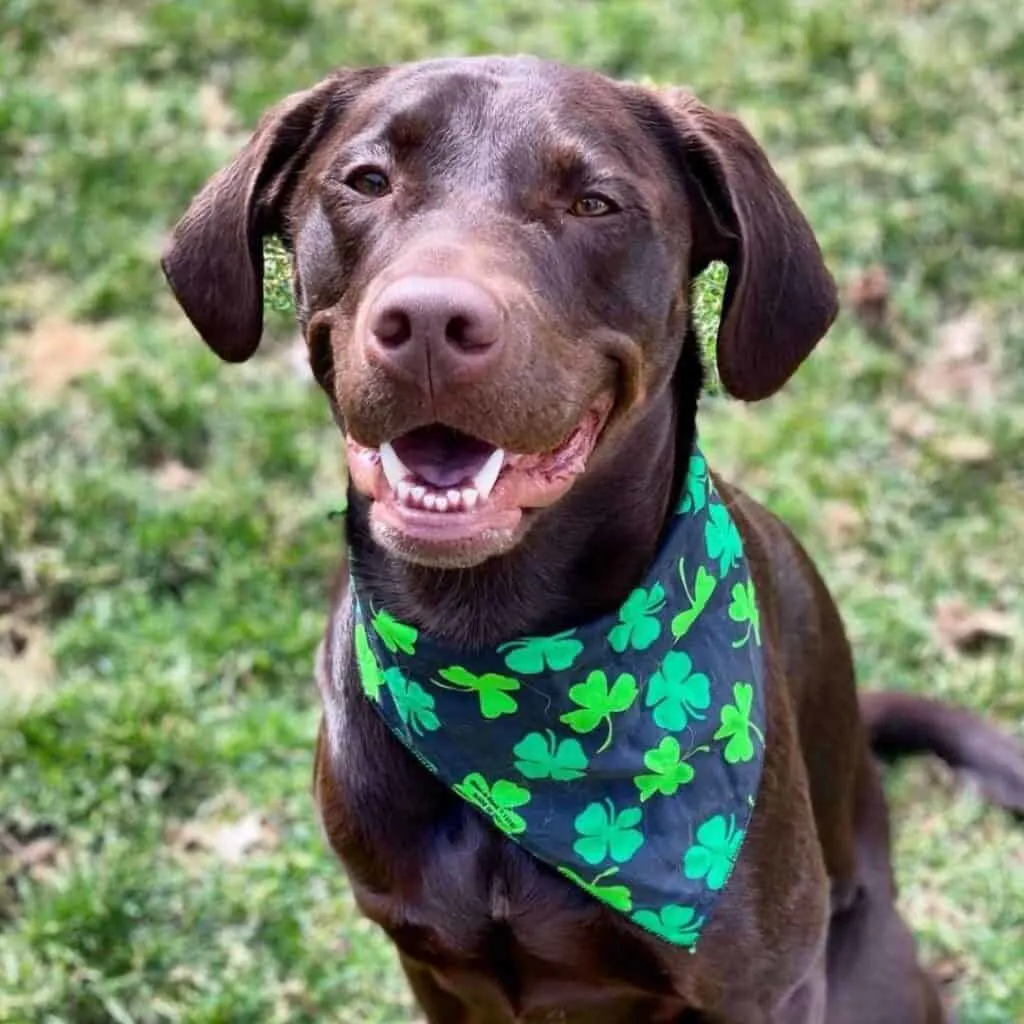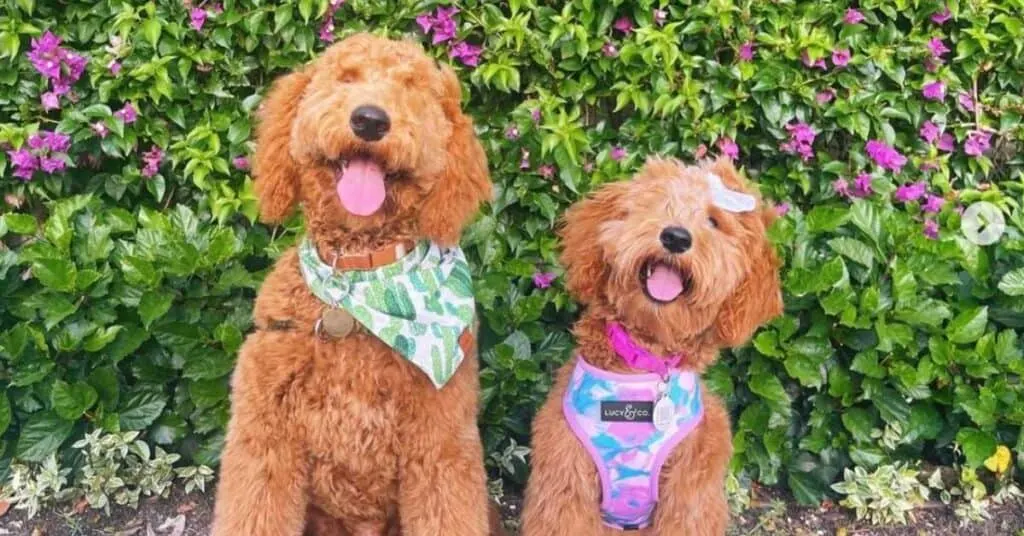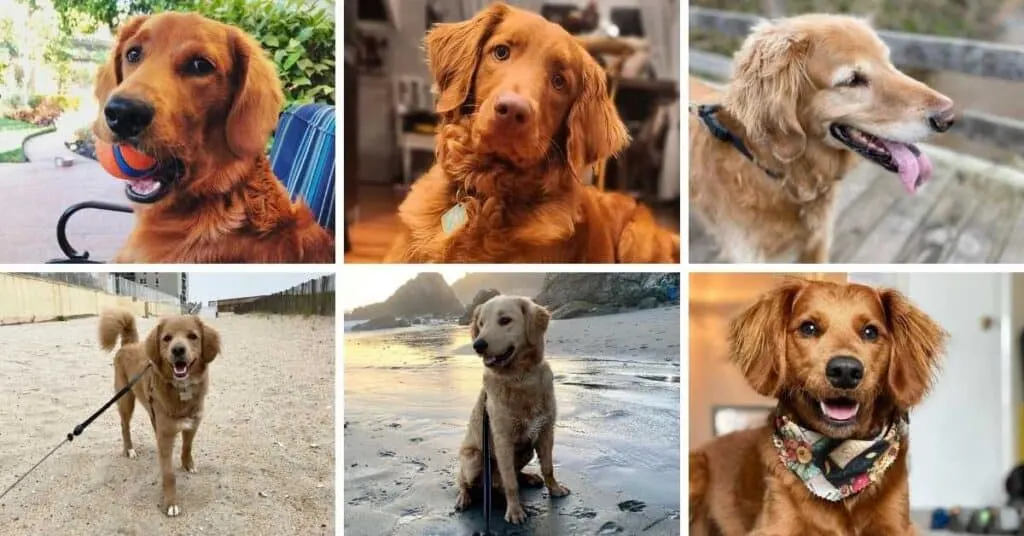
While many people think of Labradoodles as having a fluffy, curly coat similar to that of a teddy bear, that’s not always the case!
Labradoodles can come in a wide variety of coat colors and textures each adorable and unique in their own way. One of these varieties is the straight hair Labradoodle.
A Labradoodle with straight hair, also known as a flat coat Labradoodle, is the subject of much confusion and many misconceptions. While a flat coat can sometimes be referred to as an improper coat by breeders, this doesn’t necessarily mean that it’s a bad thing!
Keep reading as we’ll discuss everything you need to know about purchasing and caring for a straight haired Labradoodle.
Can Labradoodles Have Straight Hair?
Not only can Labradoodles have straight hair—it’s fairly common!
Since the Labradoodle is a mixed breed between the Labrador Retriever and the Poodle, some puppies will naturally take on more traits from each of their parent breeds. Some will have straight, flat coats like the Lab, some will have curly coats like the Poodle, and some will have wavy coats that fall somewhere in between.

Are Labradoodles Always Curly?
Contrary to what some may think, the coat of a Labradoodle isn’t always curly! In fact, it can come in a variety of textures ranging from straight, to wavy, to curly.
Straight hair comes from the DNA of the Labrador Retriever while curly hair comes from the DNA of the Poodle. Wavy hair is the “happy medium” of those two very different textures!
Many breeders strive for Labradoodle puppies that have curly hair, as many prospective owners prefer them due to their likelihood of being non-shedding and allergy-friendly. This is why you may notice more curly Labradoodles rather than straight haired ones.

Why Does My Labradoodle Have Straight Hair?
As a Labrador Retriever and Poodle cross, Labradoodles inherit traits from both of their parent breeds. Coat texture is just one of the many traits that can differ not only from litter to litter but from puppy to puppy. It’s not uncommon for some puppies in a litter to have flat coats while others will have wavy or curly coats.
A Labradoodle will have straight hair if they don’t inherit “Cu Locus,” also known as the curly coat gene or KRT71. If a Labradoodle doesn’t have this gene, they’ll end up with a flat coat like the Labrador Retriever. Since this gene is inherited from the Poodle side, a Labradoodle puppy with Cu Locus will have a coat that is more wavy or curly in texture.
Reputable breeders perform genetic testing on the parents in an attempt to produce healthier and more desirable puppies. More often than not, breeders strive for curly coated Labradoodle puppies since they are more likely to be low-shedding and allergy-friendly than flat coated puppies. This is why breeders will sometimes refer to straight coat Labradoodles as having improper coats.
Genetics are tricky to predict and no breeder can guarantee a certain coat type. However, which generation your Labradoodle is will drastically influence the odds of them having a flat coat. Keep reading as we’ll discuss Labradoodle generations in more detail and how they affect coat texture!

Which Generation of Labradoodle Has a Flat Coat?
Which generation your Labradoodle is is the best indicator of whether they’ll have a flat coat or not. Generations which are closer in DNA to a purebred Labrador Retriever will have a greater chance at having straight hair than those closer in DNA to the Poodle.
Generations can be a confusing topic so let’s start with a brief overview.
All Labradoodle generations start with the letter “F” which stands for “filial.” Filial is a term which means that it’s a mixed breed. The letter “F” is then followed by a generation number (usually 1-3) and sometimes the letter B which stands for “backcross.” This means the generation was bred back to one of the parent breeds. In the Labradoodle’s case, this is almost always the Poodle.
Here is a handy table which will show you the theoretical DNA percentages in each generation of Labradoodle…

In general, if you’re looking to add a straight hair Labradoodle to your family, you’ll want to opt for an F1 or F2 as they both have roughly 50% Labrador retriever DNA. You can also look for a breeder that backcrosses Labradoodles to Labrador Retrievers. However, those parings are extremely rare.
Keep in mind that many prospective owners are looking exclusively for curly haired Labradoodles. Even if you have a lower pick from a litter of F1 Labradoodles or F2 Labradoodles you’ll have decent odds of being able to get one with a flat coat if there are any in that litter to choose from.
Are Straight Hair Labradoodles Hypoallergenic?
While no Labradoodles can be considered completely hypoallergenic, straight haired Labradoodles have a greater risk of triggering allergy reactions than curly haired Labradoodles.
On average, a Labradoodle with a flat coat will still be more allergy-friendly than a purebred Labrador Retriever. However, even that isn’t a guarantee.
If you’re an allergy sufferer, you’re far better off choosing a Labradoodle with a coat more similar in DNA to the Poodle. The best Labradoodle generations for allergy sufferers tend to be F1BB, F2BB, F1B, and F2B in that order. You’ll notice that these generations have the highest theoretical percentages of Poodle DNA which is why they’re better for allergies.

Straight Hair Labradoodle Shedding
Straight hair Labradoodles will likely shed a moderate amount, but usually not as much as a purebred Lab. For some people this is a dealbreaker while others don’t mind cleaning up a little fur around the house.
Labradoodle shedding doesn’t have to be a nightmare! There are some easy things you can do to manage your Labradoodle’s shedding like brushing and bathing frequently, feeing a healthy diet, and using the proper grooming equipment.
Here are my must-have grooming tools for shedding Labradoodles:
- Chris Christensen Big G Slicker Brush: Yes, I know it’s expensive. But it’s by and large the best brush on the market and once you try it you’ll never be able to go back to generic brushes again!
- FURminator De-Shedding Tool: This tool is a saving grace for shedding Labradoodles. It helps remove loose hair BEFORE it gets all over the house…all without damaging your dog’s coat.
- Burt’s Bees Shed Control Shampoo: While many shampoos designed to control shedding are full of harsh chemicals, this is a natural choice that is great for dogs with sensitive skin.
In addition to these grooming tools, you may want to consider investing in a vacuum specifically designed to handle pet hair. Here are some top-rated options from Amazon:
Flat Coat Labradoodle Grooming
One advantage to having a flat coat Labradoodle is how easy grooming is compared to dogs with curly coats. While you may deal with some shedding, you’ll have a much easier time avoiding matting and you won’t have to brush them quite as frequently.
Just as your day-to-day grooming may be less or a burden, so will taking your dog to the groomer. If your dog sheds, they’ll likely need haircuts less often than a non-shedding dog would.
Related: Short Labradoodle Haircut Ideas: 20 Before and After Photos!
For those without allergies, this may be a worthwhile tradeoff! Keep in mind that less maintenance doesn’t equal no maintenance. You’ll still want to brush and bathe your Labradoodle regularly while taking your dog in for periodic haircuts and nail trimming. Don’t forget to keep their ears clean as well!

Flat Coat Labradoodle Puppies: Pros and Cons
Pros
- Cost: Flat coats are normally found in F1 or F2 Labradoodles which tend to be lower cost than backcrosses like the F1B or F1BB generations. As such, you’ll normally pay less than the average price of a Labradoodle.
- Less Competition for Litter Picks: There is far more demand for curly hair Labradoodles versus those with straight coats. This means, even if you don’t have one of the first few picks from a littler of Labradoodles, there is a decent shot that any potential flat coated puppies will get passed up until it’s your turn.
- Less Daily Grooming: As we talked about, there is less day-to-day maintenance required to keep your dog’s coat looking great and free from matting and tangles!
- Less Frequent Haircuts: Since your dog may shed, this means that they’ll likely have to be taken to the groomer less frequently for haircuts than a curly haired Labradoodle would. Over the course of your Labradoodle’s lifespan, this could add up to hundreds or even thousands of dollars in savings.
- Cute Labrador Retriever Appearance: If you love the look of a Labrador Retriever, it’s hard to pass up these adorable, straight haired pups!
Cons
- Shedding: If you have a Labradoodle with an improper coat, you should count on at least some shedding. This bothers some people more than others. However, if you obsess about a clean house and the thought of dog hair on your clothes disgusts you, a straight haired Labradoodle may not be for you.
- Allergies: If you have allergies, you should probably opt for a Labradoodle with a curlier, more allergy-friendly coat.
- No Teddy Bear Poodle Appearance: If you’re looking for a Labradoodle with a fluffy, teddy bear appearance, this probably isn’t the dog for you.

What Coat Will My Labradoodle Puppy Have?
A Labradoodle’s puppy coat will oftentimes not resemble exactly how their adult coat will look. However, you’ll be able to predict whether their coat will be proper or improper based on what’s called “furnishings.”
Furnishings are the longer hair that may be present on your Labradoodle’s face around their mustache and eyebrows. These hairs are what give them the “scruffy” look that more closely resembles a Poodle rather than a Labrador Retriever.
The easiest way to spot furnishings is on the bridge of a puppy’s nose. Below is an example of a Labradoodle with furnishings vs one without.

Will a Labradoodle Puppy Coat Change?
Labradoodles a born with a super soft puppy coat they they shed around 6 months to a year of age. Their adult coat tends to be less soft and more like fleece, wool, or hair.
So while your Labradoodle’s puppy coat will change, you shouldn’t expect a puppy with an Improper coat to suddenly stop shedding or become curlier. You also shouldn’t expect a puppy with furnishings to begin shedding significantly more as they age.
Sudden, drastic changes in shedding could be the result of a health issue in your Labradoodle.

Final Thoughts
Just because a Labradoodle has a flat coat doesn’t mean that there’s anything wrong with them. In fact, straight haired Labradoodles are super adorable! Whether you opt for a flat or curly haired Labradoodle is entirely up to what you’re looking for in your future dog.
Hopefully, the information in this article helps you make the best, most informed decision possible for your family!






![What is a Parti Labradoodle? [Photo Gallery & FAQs] what-is-a-parti-labradoodle](https://populardoodle.com/wp-content/uploads/2021/07/what-is-a-parti-labradoodle-1024x536.jpg.webp)




